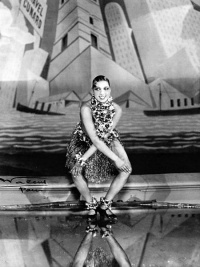1920s
From The Art and Popular Culture Encyclopedia

(Photo by Walery)
|
Related e |
|
Featured: |
The 1920s is a decade that is sometimes referred to as the "Jazz Age" or the "Roaring Twenties," usually applied to America. In Europe the decade is referred to as the Golden Twenties in Anglophone countries, Les Années Folles in France, and Weimar Berlin in Germany.
Since the closing of the 20th Century, the 1920s has drawn close associations with the 1950s and 1990s, especially in the United States. The three decades are regarded as periods of economic prosperity, which lasted throughout almost the entire decade following a tremendous event that occurred in the previous decade (World War I and Spanish flu in the 1910s, World War II in the 1940s, and the end of the Cold War in the late 1980s).
Despite the comparisons, however, there were a number of differences. Firstly, Weimar Republic Germany, like many other European countries, had to face a severe economic downturn in the opening years of the decade, because of the enormous debt caused by the war as well as the one-sided Treaty of Versailles. Such a crisis would culminate with a devaluation of the Mark in 1923, eventually leading to severe economic problems and the rise of the Nazis.
Second, the decade was characterized by the rise of radical political movements, especially in regions that were once part of empires. Communism began attracting large numbers of followers following the success of the October Revolution and the Bolsheviks' determination to win the subsequent Russian Civil War. The Bolsheviks would eventually adopt semi-capitalist policies--New Economic Policy--from 1921 to 1928. The 1920s also experienced the rise of the far-right in Europe and elsewhere, starting with Fascism in the world as an antidote to Communism.
The Stock Market collapsed during October 1929 (see Black Tuesday) and drew a line under the prosperous 1920s.
Culture
- Prohibition — legal attempt to end consumption of alcohol in Canada, the USA, Norway and Finland
- Youth culture of The Lost Generation; flappers, the Charleston, and bobbed hair
- "The Jazz Age" — jazz and jazz-influenced dance music widely popular
- Women's suffrage movement continues to make gains as women obtain full voting rights in Denmark in 1915, in the USA in 1920, and in England in 1928; and women begin to enter the workplace in larger numbers
- In the US, gangsters and the rise of organized crime, often associated with bootleg liquor, in defiance of Prohibition.
- First commercial radio station in the U.S. goes on air in Pittsburgh, in 1920, and radio quickly becomes a popular entertainment medium
- First feature-length motion picture with a soundtrack (Don Juan) is released in 1926. First part-talkie (The Jazz Singer) released in 1927, first all-talking feature (Lights of New York) released in 1928 and first all-color all-talking feature (On with the Show) released in 1929.
- Beginning of surrealist movement
- Beginning of the Art Deco movement
- Fads such as marathon dancing, mah-jongg, crossword puzzles and pole-sitting are popular
- The height of the clip joint
- The Harlem Renaissance
- The Scopes Monkey Trial (1925) which declared that John T. Scopes had violated the law by teaching evolution in schools, creating tension between the competing theories of creationism and evolution.
- Bishop James Cannon, Jr. becomes a U.S. temperance movement leader.
- The Group of Seven (artists)
- The tomb of Tutankhamun is discovered intact by Howard Carter (1922). This begins a second revival of Egyptomania.
Subcultures
In the 1920s, American Jazz music and motor cars were at the centre of a European subculture which began to break the rules of social etiquette and the class system (See also Swing Kids). In America, the same flaming youth subculture was "running wild" but with the added complication of alcohol prohibition. Canada had prohibition in some areas, but for the most part, thirsty Americans coming over the border found an oasis. As a result, smuggling escalated as crime gangs became organised. In the southern United States, Mexico and Cuba were popular with drinkers. Thus, a drinking subculture grew in size and a crime subculture grew along with it. Other drugs were used as alternatives to alcohol. When prohibition ended, the subculture of drink, drugs and jazz did not disappear, and neither did the gangsters.
Mentioned in
- Surrealism
- Documents (journal)
- Jean Vigo
- History of subcultures in the 20th century
- Modern architecture
- André Masson
- Folies Bergère
- Noise music
- 1920s Berlin
- Harlem Renaissance
- German Expressionism
- Theatre of the Absurd
- European comics
- Sexual revolution
- Cut-up technique
- Silent film
- Musidora
- André Kertész
- Samuel Roth
- Lee Miller
- Roaring Twenties
- Flapper
- New Criticism
- Ero guro nansensu
- Djuna Barnes
- Swing music
- Cinema pur
- Storyville
- Kino-Pravda
- International style (architecture)
- Golden Twenties
- Avant-garde film in Europe
- Années Folles

